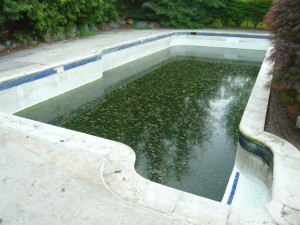If you live in a seasonal climate where a swimming pool is only open for the summer months, sometimes a pool will not be opened for a summer for a variety of reasons. Sometimes the homeowner is traveling, away from the home for extended periods, or the pool just won’t get much use. Other times it may be too much time, money or hassle for an owner to open the pool, though they still want to make sure it is in good operating condition in the future. Here are a few tips for your Michigan Swimming Pool if you choose not to to open it for a season or more.
- Check the cover. Depending on what type you have, either the plastic with waterbags or the safety cover, you will have different issues. Check the plastic cover for holes and tears as well as make sure all of your waterbags are solid. If you have this type of cover on your pool, the water on top of the cover may become dirty with algae, leaves, debris and more. You may want to hire a pool company to drain the cover for you, and check the pool over while they are there. If the dirty water passes through your cover due to a pin hole, large hole, or a cover that falls in, your water underneath can become contaminated and cause staining and algae growth. *You can use a pump to pump the cover off yourself, but be very careful. An unknowing homeowner has been known to pump out too much water, not realizing there was a hole in the cover. This can lead to MAJOR problems with vinyl liners floating, or fiberglass or gunite pools not having enough water in them to counter hydrostatic pressure in the ground.
- For pools with a safety cover, check the water underneath about 2x per season, and add chlorine if it seems like the water quality is diminished. You can also pump water off the top of the cover if needed. Sometimes, if a pool will be closed for more than one summer, you may want to pump some of the water out of the pool to make room for more. It may be a good idea to hire a professional to do this with you.
- Look over the equipment and make sure nothing looks broken or cracked.
- Add some chlorine and algaecide underneath your cover to the pool. Liquid chlorine can be added underneath a corner of the cover – make sure you know the proper amount to add. A vinyl liner can become bleached with too much chlorine, though staining and scale can occur with not enough. You can use granular shock or chlorine with a gunite (concrete) pool, and with fiberglass. You don’t want to use granular with a liner pool because if the chlorine settles to the bottom before it dissolves, it can cause bleaching and spots in the liner.
- You can also add algaecide, and even a product called a Winter Pill to inhibit stain and scale from forming.
- Pay attention to your yard and watch for any signs of water in the yard, areas that look suspicious, or anything that concerns you. A quick service call from your favorite service company can also put your concerns to rest and ensure when you do open the pool next it is ready to go.













